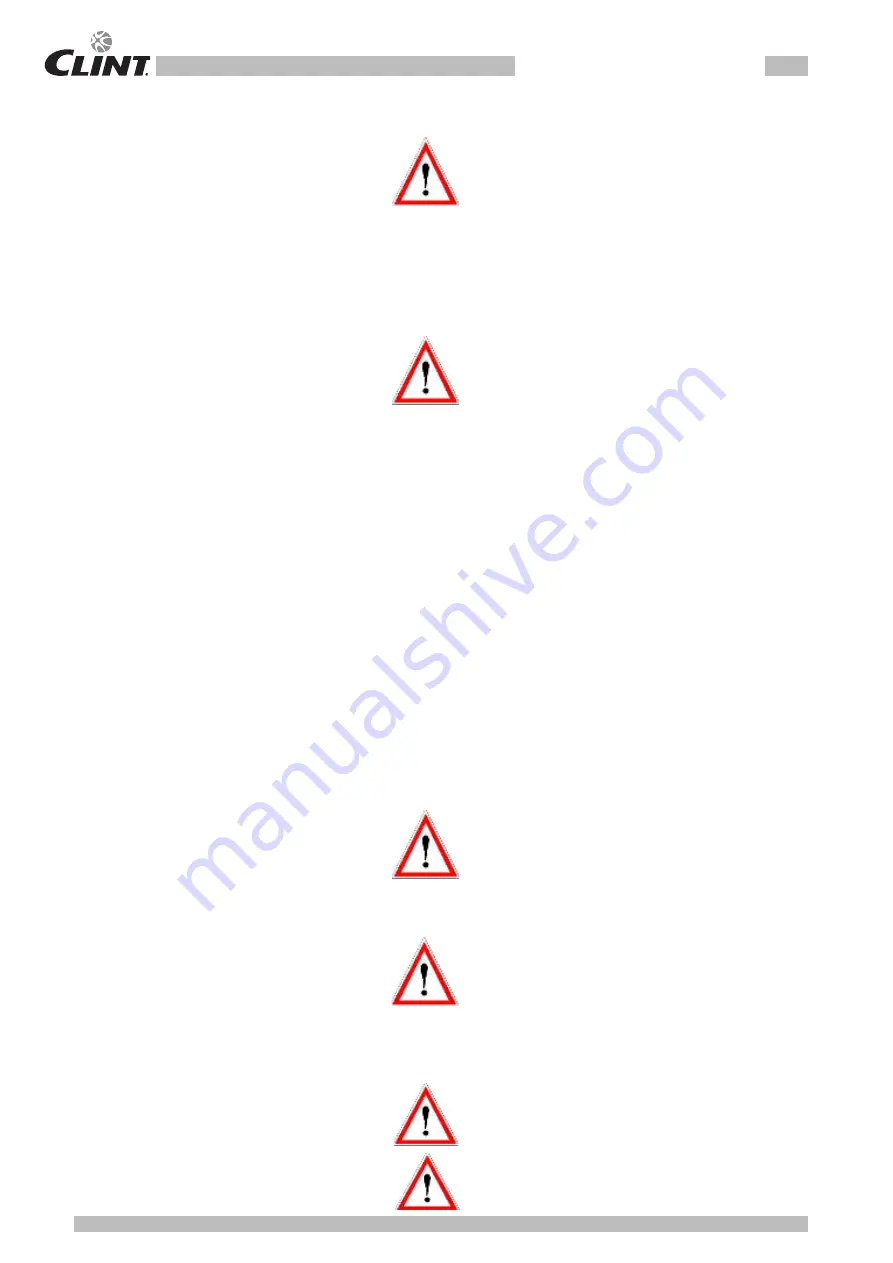
18
CHA - CHA/K
5.2.2 Evaporatore
È di importanza fondamentale che l’ingresso dell’acqua
avvenga in corrispondenza della connessione contras-
segnata con la targhetta “ENTRATA ACQUA”.
Per gli attacchi idraulici vengono utilizzate connessioni
filettate maschio o flangiate, a seconda dei modelli (fare
riferimento ai disegni dimensionali, così come per la
posizione degli attacchi).
È di fondamentale importanza realizzare il circui-
to idraulico in modo tale che venga garantita la
costanza della portata d’acqua allo scambiatore
in qualsiasi condizione di funzionamento. Una
portata d’acqua non costante può essere accettata
solo per i desurriscaldatori presenti nelle unità.
Poiché la richiesta frigorifera dell’utenza non coincide general-
mente con quella erogata dai compressori, l’azione degli stessi
è molto spesso intermittente. Negli impianti a basso contenuto
d’acqua, dove l’effetto di inerzia termica della stessa è meno
sensibile, è opportuno verificare che il contenuto dell’impianto
soddisfi la seguente relazione:
V > P/115n
dove:
V = volume d’acqua (litri)
P = potenza resa dall’unità (Watt)
n = numero di gradini di parzializzazione.
Se non vengono raggiunti i volumi sopraccitati, è necessario prevedere
un serbatoio d’accumulo tale che, sommato alla capacità dell’impianto,
venga raggiunto il valore fornito dalla relazione riportata. Tale serbatoio
non richiede particolari accorgimenti, salvo che, allo stesso modo delle
tubature dell’acqua refrigerata, va isolato al fine di non penalizzare la
resa dell’impianto e di evitare fenomeni di condensazione.
È buona norma installare una valvola di sicu-
rezza sul circuito idraulico (se non già presen-
te). In caso di anomalie gravi nell’impianto (ad
es. incendio) essa permetterà di scaricare il
sistema evitando possibili scoppi. Collegare
sempre lo scarico ad una tubazione di diame-
tro non inferiore a quello dell’apertura della
valvola, e convogliarlo in zone nelle quali il
getto non possa recare danno alle persone.
Attenzione!
Durante le operazioni di allacciamento idrau-
lico non operare mai con fiamme libere in
prossimità o all’interno dell’unità.
5.3
COLLEGAMENTI ELETTRICI
5.3.1 Generalità
Queste operazioni devono essere effettuate
solo da personale specializzato.
Prima di effettuare qualsiasi operazione su parti
elettriche assicurarsi che non vi sia tensione.
5.2.2 Evaporator
It is vitally important that the water enters
the unit from the connection point marked
with the “WATER INLET” plate.
Threaded or flanged male unions, depending on the
models, are used to make water connections (please
refer to the scale drawings which also show the position
of the unions).
It is vitally important to connect the water
circuit so that the flow of water to the ex
-
changer is always constant under all oper-
ating conditions. A variable flow of water
is only accepted for the desuperheaters
contained in units.
As the demand for cooling by utilities does not gener-
ally coincide with what is delivered by the compressors,
they often work intermittently. In units with a low water
content, where the effect of thermal inertia is not felt so
much, the system should be checked to make sure it
satisfies the following relation:
V > P/115n
where:
V = volume of water (litres)
P = power capacity of the unit (Watts)
n = number of capacity steps.
If the above volumes are not obtained, a storage tank should
be installed so as to satisfy the above relation when added
to the capacity of the system. This tank requires no special
features; it just needs to be isolated, just like the chilled water
pipes, so as not to affect the performance of the system and
to prevent the formation of condensation.
A safety valve should be installed on the
water circuit (if not already fitted). In case
of serious system faults (e.g. fire) this will
allow the system to be drained in order to
prevent the risk of explosions. Always con-
nect the drain to a pipe with a diameter not
less than that of the valve opening and install
the outlet in an area where the jet cannot
cause harm to people.
Attention!
While connecting the water circuit, never
work with naked flames near to or inside
the unit.
5.3
ELECTRICAL CONNECTIONS
5.3.1 General
These operations may only be carried out
by specialised staff.
Before carrying out any operations on elec-
trical components, make sure the unit is dis-
connected from the mains power supply.





























